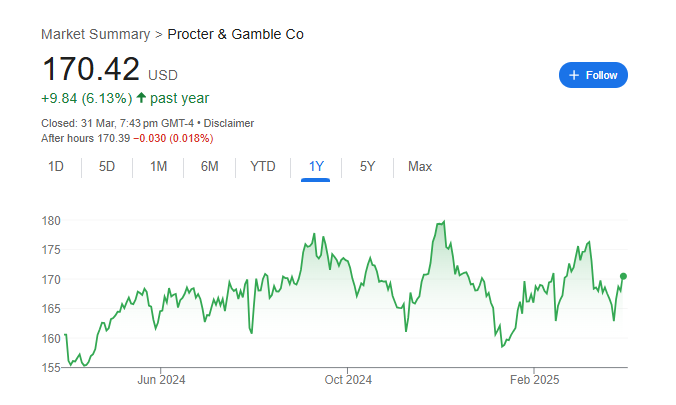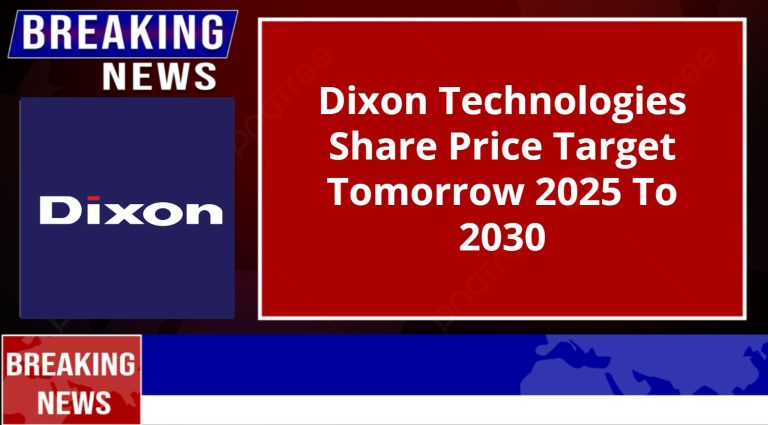PG Share Price Target Tomorrow 2025 To 2030
Procter & Gamble (PG) is a global leader in consumer goods, known for its wide range of products in personal care, health care, home care, and beauty. Some of its popular brands include Tide, Pampers, Gillette, and Oral-B. The company is headquartered in Cincinnati, USA, and has a strong presence in multiple markets worldwide. PG Share Price on NSE as of 1 April 2025 is 170.42 USD.
Current Market overview of PG Share Price
- Open: 13,601.00
- High: 13,900.00
- Low: 13,451.30
- Previous Close: 13,600.65
- Volume: 5,423
- Value (Lacs): 738.75
- VWAP: 13,684.18
- Mkt Cap (Rs. Cr.): 44,219
- Face Value: 10
- UC Limit: 16,320.75
- LC Limit: 10,880.55
- 52 Week High: 17,745.00
- 52 Week Low: 12,105.60
PG Share Price Target Tomorrow 2025 To 2030
| PG Share Price Target Years | PG Share Price |
| 2025 | $ 185 |
| 2026 | $ 200 |
| 2027 | $ 220 |
| 2028 | $ 240 |
| 2029 | $ 260 |
| 2030 | $ 280 |
PG Share Price Chart

Key Factors Affecting PG Share Price Growth
-
Global Demand for Consumer Goods
Procter & Gamble (PG) is a leading consumer goods company with products in categories like hygiene, healthcare, and home care. The demand for these products, especially in emerging markets, directly impacts PG’s revenue and, in turn, its share price. A rise in consumer demand boosts the company’s profitability, leading to higher share prices. -
Product Innovation and Brand Strength
PG invests heavily in research and development to create new products that meet consumer needs. Innovation drives the success of popular brands like Tide, Pampers, and Gillette. If PG can maintain strong brand loyalty and introduce successful products, it helps grow its market share, positively affecting its stock price. -
Raw Material Costs
The prices of raw materials, such as chemicals and packaging, have a significant impact on PG’s production costs. Fluctuations in these costs, often driven by global supply chains and economic conditions, can affect PG’s profit margins. A rise in raw material prices could put pressure on profits, which might hurt the share price. -
Economic Conditions
Global and regional economic conditions play a crucial role in PG’s share price growth. In times of economic downturn or recession, consumer spending typically declines, affecting PG’s sales. On the other hand, during periods of economic growth, higher disposable income leads to increased demand for PG’s products, supporting share price growth. -
Regulatory Changes
PG operates in various countries and is subject to regulations around product safety, environmental impact, and corporate governance. Changes in government policies or regulations can affect PG’s operations and profitability. For instance, stricter environmental laws or product recall issues can harm the company’s reputation and stock performance. -
Competitive Landscape
PG faces competition from both local and global companies in its product categories. New players in the market or aggressive pricing strategies from competitors can influence PG’s market share and profitability. If PG fails to maintain its competitive edge, it could experience slower growth, negatively impacting its stock price. -
Global Events and Supply Chain Issues
Global events such as pandemics, geopolitical tensions, or natural disasters can disrupt PG’s supply chains or production. For example, during the COVID-19 pandemic, many companies, including PG, faced logistical challenges. Disruptions in supply chains can delay production, leading to stock shortages and, in turn, affecting share prices negatively.
Risks and Challenges for PG Share Price
-
Fluctuating Raw Material Prices
Procter & Gamble (PG) is heavily reliant on raw materials such as chemicals, oils, and packaging for its consumer goods. The prices of these raw materials can be volatile, influenced by global supply chains, natural disasters, or geopolitical issues. A significant increase in raw material costs could squeeze PG’s profit margins, leading to lower stock prices. -
Economic Slowdowns
In times of economic recession or downturns, consumer spending often drops. Since PG’s products are non-essential in nature, a slowdown in consumer spending can reduce demand for its products. This decline in sales can result in lower revenue and earnings, which could negatively impact PG’s stock performance. -
Intense Competition
PG operates in a competitive market with both established players and new entrants. Companies like Unilever, Colgate-Palmolive, and Johnson & Johnson pose constant competition, especially in sectors such as personal care and cleaning products. Increased competition can lead to price wars, loss of market share, or a decline in consumer loyalty, all of which can harm PG’s share price. -
Regulatory and Legal Risks
PG operates globally, and changes in government regulations or legal issues could pose risks to its business. Stricter environmental regulations, health and safety standards, or new taxes can increase operating costs or limit product sales in certain regions. Legal issues, such as lawsuits related to product safety or environmental damage, can damage the company’s reputation and hurt investor confidence. -
Supply Chain Disruptions
Global events such as natural disasters, pandemics, or geopolitical tensions can disrupt PG’s supply chains. For instance, the COVID-19 pandemic created global supply chain issues, leading to product shortages and delays. Any future disruptions can hurt PG’s ability to meet consumer demand, impacting its financial performance and share price. -
Currency Fluctuations
PG generates significant revenue from international markets. However, fluctuations in currency exchange rates can negatively impact its earnings from foreign markets when converted back to U.S. dollars. A stronger U.S. dollar, for example, can reduce the value of PG’s international revenues, affecting its overall profitability and stock price. -
Changes in Consumer Preferences
Consumer preferences can change over time, and PG must adapt to these shifts to remain competitive. For example, if there is a sudden increase in demand for eco-friendly or organic products, PG might face challenges in adjusting its product lines. Failure to innovate and meet changing consumer expectations could lead to a loss of market share, which would negatively impact the company’s stock price.
Read Also:- Power Grid Share Price Target Tomorrow 2025 To 2030







